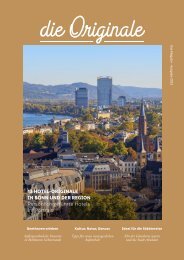LUXAIR_LUXiClub_So12 ls
p o
p
o
Create successful ePaper yourself
Turn your PDF publications into a flip-book with our unique Google optimized e-Paper software.
Number 43, Fall 2002
cartographic perspectives 25
Hillshading With Oriented Halftones
Hillshading renders a surface with a three-dimensional appearance using
shades of gray. Although shades appear as continuous tones, they
must undergo a halftoning process for use with most computer output
devices. This process generally uses one pattern of black and white pixels
for each shade of gray, while attempting to make patterns associated
with black and white pixels as difficult to detect as possible.
The method described in this paper adds aspect information to hillshaded
maps with oriented halftones. Twelve orientations of clustered-dot
ordered dithers represent 30° intervals of aspect. Additionally, dithering
matches sixteen shades of gray associated with analytical hillshading,
with each interval representing 16 of 256 shades of gray. This process
allows pattern and gray tone representations of the surface simultaneously.
illshading is a cartographic technique that has been used to represent
continuous surfaces with shades of gray for hundreds of years
(Imhof, 1982; Horn, 1981; Horn, 1982; Robinson et al. 1995). The tonal
variations on the resulting map give the impression of a three-dimensional
surface (Clarke, 1995; Horn, 1981; Horn, 1982). This effect is based on
chiaroscuro, the interplay of light and shading commonly used by Renaissance
artists (Burrough and McDonnell, 1998; Horn, 1981; Horn, 1982). To
achieve this effect, the cartographer selects a direction of illumination and
makes surface elements most directly illuminated bright and those more
obliquely illuminated increasingly dark. Such hillshading uses the Lambertian
assumption of an ideal diffuse reflector approximated by a matte
surface. A brightness value is calculated for each surface element based on
the cosine of the angle θ between the selected illumination vector and the
normal vector for each surface element.
Historically, cartographers working with hillshading focused on the
methods of producing this effect, but also needed to concern themselves
with the technologies for reproducing the maps. The hachure method
devised by Lehmann (1799) used fine lines drawn in the direction of steepest
topographic gradient. It was widely used because copper engraving, a
popular reproduction technique for maps at the time, could not reproduce
continuous shades of gray, but worked well for black lines on white paper
to approximate grayscales. Only after the patent of the halftone screen
in 1865 and the crossline screen in 1869, did lithographs that allowed the
continuous variations of shades of gray become a commercial success
(Horn, 1981; Horn, 1982).
Computer cartographers working with hillshading also necessarily
concerned themselves with reproduction methods. Before plotters could
output continuous shades of gray, researchers automated two methods
devised by Tanaka (1932 and 1950) that used contour lines to approximate
the hillshading effect. Peucker et al. (1972) were the first to automate
these methods. An alternative algorithm for Tanaka’s orthographic relief
method was later suggested by Yoeli (1976). Brassel et al. (1974) devised a
Patrick J. Kennelly*
Assoc. Research Professor
& GIS Manager
Montana Tech of the
University of Montana
Montana Bureau of Mines
and Geology
1300 W. Park Street
Butte, MT 59701
INTRODUCTION
“Historically, cartographers
working with hillshading
focused on the methods of
producing this effect, but also
needed to concern themselves
with the technologies for
reproducing the maps.”
*Currently Assistant Professor, CW Post Campus / Long Island University,
720 Northern Blvd., Brookville, NY 11548. Patrick.Kennelly@liu.edu.















